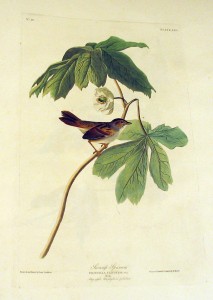 “The shores and such flat sand-bars as are overgrown with grasses and rank weeds, along the Mississippi, from its mouth to a great height, as well as the swamps that occur in the woods, within a short distance from the margins of that river, are the resorts of the Swamp Sparrow, during autumn and winter. Although these birds do not congregate in flocks, their numbers are immense. They form the principal food of the many Sparrow Hawks, Pigeon Hawks, and Hen-harriers, which follow them as well as several other species, on their return from the Middle Districts, where they go towards spring, for the purpose of breeding. In those districts they continue to prefer low swampy places, damp meadows, and the margins of creeks and rivers.
“The shores and such flat sand-bars as are overgrown with grasses and rank weeds, along the Mississippi, from its mouth to a great height, as well as the swamps that occur in the woods, within a short distance from the margins of that river, are the resorts of the Swamp Sparrow, during autumn and winter. Although these birds do not congregate in flocks, their numbers are immense. They form the principal food of the many Sparrow Hawks, Pigeon Hawks, and Hen-harriers, which follow them as well as several other species, on their return from the Middle Districts, where they go towards spring, for the purpose of breeding. In those districts they continue to prefer low swampy places, damp meadows, and the margins of creeks and rivers.
It is a timid species, destitute of song, and merely uttering a single cheep, which is now and then heard during the day, but more frequently towards evening. They skulk along the weeds with activity, and feed principally upon the seeds of grasses, with a few insects, sometimes wading in shallow water. When wounded and forced to fall in the stream, they swim off to the nearest tuft of grass and hide in it. Their flight is short, low, and assisted by strong jerking motions of the body and tail, accompanied by a rustling of the wings. They alight by dropping suddenly amongst the weeds, seldom making towards a high tree. They are rarely if ever met with in dry woodlands.”
–J. J. Audubon, Ornithological Biography, I (1831), 331 [excerpted].